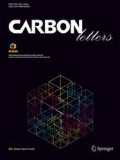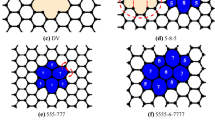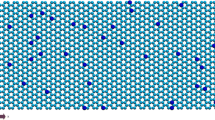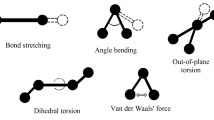Abstract
The behaviour of semiconducting graphene quantum dots (GQDs), as good candidates for various biological carrier applications and optical sensing, are necessary to be studied under various conditions. In this study, GQD models were generated according to the geometrical and chemical specifications of synthesized GQDs to achieve the most realistic models. The GQDs’ bandgap and distribution of their electric surface charges were obtained using computational chemistry method. Finite element analysis was conducted on pristine and defective GQDs to study Young and shear modulus. Buckling load and resonant frequency modes of GQDs were calculated analytically and demonstrated under various boundary conditions. The dimension of GQDs has an average of 3.5 ± 0.4 nm, with an interlayer spacing of 0.36–0.40 nm. Computational chemistry studies revealed the characteristic zero-band-gap nature of graphene. Finite element studies showed that the by introducing the inevitable dislocation, mono atom vacancy and Stone–Wales defects to GQD models, their mechanical properties reduces to approach data from experimental investigations, whereas an increase in the number of layers does not influence the obtained results significantly.







Similar content being viewed by others
Data availability
The data that support the findings of this study are available from the corresponding author upon reasonable request.
Abbreviations
- AD:
-
Atomistic dislocation
- AV:
-
Atom vacancy
- CNT:
-
Carbon nanotube
- DFT:
-
Density functional theory
- FE:
-
Finite element
- GQD:
-
Graphene quantum dots
- HOMO:
-
Highest occupied molecular orbitals
- L-J:
-
Lennard-Jones
- LUMO:
-
Lowest unoccupied molecular orbitals
- MD:
-
Molecular dynamics
- QY:
-
Quantum yield
- SW:
-
Stone–Wales
References
Ma L, Kohli M, Smith A (2013) Nanoparticles for combination drug therapy. ACS Nano 7:9518–9525
Dong Y, Shao J, Chen C, Li H, Wang R, Chi Y, Lin X, Chen G (2012) Blue luminescent graphene quantum dots and graphene oxide prepared by tuning the carbonization degree of citric acid. Carbon N Y 50:4738–4743. https://doi.org/10.1016/j.carbon.2012.06.002
Wang S, Chen ZG, Cole I, Li Q (2015) Structural evolution of graphene quantum dots during thermal decomposition of citric acid and the corresponding photoluminescence. Carbon N Y 82:304–313. https://doi.org/10.1016/j.carbon.2014.10.075
Bagheri Z, Ehtesabi H, Rahmandoust M, Ahadian MM, Hallaji Z, Eskandari F, Jokar E (2017) New insight into the concept of carbonization degree in synthesis of carbon dots to achieve facile smartphone based sensing platform. Sci Rep. 7:1–11. https://doi.org/10.1038/s41598-017-11572-8
Rahmandoust M, Öchsner A (2009) Influence of structural imperfections and doping on the mechanical properties of single-walled carbon nanotubes. J Nano Res. 6:185–196. https://doi.org/10.4028/www.scientific.net/JNanoR.6.185
Rahmandoust M, Öchsner A (2012) On finite element modeling of single- and multi-walled carbon nanotubes. J Nanosci Nanotechnol. https://doi.org/10.1166/jnn.2012.4521
Rahmandoust M, Öchsner A (2015) Young’s modulus variation of carbon nanotubes due to defects associated with atomic reconstruction of random vacancies. J Comput Theor Nanosci 12:2281–2286. https://doi.org/10.1166/jctn.2015.4020
Ghavamian A, Rahmandoust M, Öchsner A (2012) A numerical evaluation of the influence of defects on the elastic modulus of single and multi-walled carbon nanotubes. Comput Mater Sci 62:110–116. https://doi.org/10.1016/j.commatsci.2012.05.003
Dehghan Pir MM, Rahmandoust M, Öchsner A (2017) Obtaining global equations for the Young’s modulus of perfect and defective carbon nanotubes. Mater Res Express. 4(125012):1–15. https://doi.org/10.1088/2053-1591/aa9bae
Mavalizadeh S, Rahmandoust M, Öchsner A (2011) Numerical investigation of the overall stiffness of carbon nanotube based composite materials. J Nano Res. https://doi.org/10.4028/www.scientific.net/JNanoR.13.47
Eslami Afrooz I, Öchsner A, Rahmandoust M (2012) Effects of the carbon nanotube distribution on the macroscopic stiffness of composite materials. Comput Mater Sci 51:422–429. https://doi.org/10.1016/j.commatsci.2011.08.003
Farsadi M, Öchsner A, Rahmandoust M (2013) Numerical investigation of composite materials reinforced with waved carbon nanotubes. J Compos Mater. https://doi.org/10.1177/0021998312448495
Rahmandoust M, Ayatollahi MR (2016) Characterization of carbon nanotube based composites under consideration of defects. Springer, Cham. https://doi.org/10.1007/978-3-319-00251-4
Lee C, Wei X, Kysar JW, Hone J (2008) Measurement of the elastic properties and intrinsic strength of monolayer graphene. Science 321:385–388. https://doi.org/10.1126/science.1157996
Chen H, Müller MB, Gilmore KJ, Wallace GG, Li D (2008) Mechanically strong, electrically conductive, and biocompatible graphene paper. Adv Mater 20:3557–3561. https://doi.org/10.1002/adma.200800757
Tsoukleri G, Parthenios J, Papagelis K, Jalil R, Ferrari AC, Geim AK, Novoselov KS, Galiotis C (2009) Subjecting a graphene monolayer to tension and compression. Small 5:2397–2402. https://doi.org/10.1002/smll.200900802
Rasuli R, Irajizad A, Ahadian MM (2010) Mechanical properties of graphene cantilever from atomic force microscopy and density functional theory. Nanotechnology. 21:185503. https://doi.org/10.1088/0957-4484/21/18/185503
Mohammadi M, Farajpour A, Moradi A, Ghayour M (2014) Shear buckling of orthotropic rectangular graphene sheet embedded in an elastic medium in thermal environment. Compos Part B Eng. 56:629–637. https://doi.org/10.1016/J.COMPOSITESB.2013.08.060
Mukhopadhyay T, Mahata A, Adhikari S, Asle Zaeem M (2017) Effective mechanical properties of multilayer nano-heterostructures. Sci Rep. 7:15818
Van Lier G, Van Alsenoy C, Van Doren V, Geerlings P (2000) Ab initio study of the elastic properties of single-walled carbon nanotubes and graphene. Chem Phys Lett 326:181–185. https://doi.org/10.1016/S0009-2614(00)00764-8
Ni Z, Bu H, Zou M, Yi H, Bi K, Chen Y (2010) Anisotropic mechanical properties of graphene sheets from molecular dynamics. Phys B Condens Matter. 405:1301–1306. https://doi.org/10.1016/J.PHYSB.2009.11.071
Min K, Aluru NR (2011) Mechanical properties of graphene under shear deformation. Appl Phys Lett 98:013113. https://doi.org/10.1063/1.3534787
Shokrieh MM, Rafiee R (2010) Prediction of Young’s modulus of graphene sheets and carbon nanotubes using nanoscale continuum mechanics approach. Mater Des 31:790–795. https://doi.org/10.1016/J.MATDES.2009.07.058
Qin Q, An H, He C, Xie L, Peng Q (2019) Anisotropic and temperature dependent mechanical properties of carbon honeycomb. Nanotechnology. 30:325704. https://doi.org/10.1088/1361-6528/ab14a1
Reddy CD, Rajendran S, Liew KM (2006) Equilibrium configuration and continuum elastic properties of finite sized graphene. Nanotechnology. 17:864–870. https://doi.org/10.1088/0957-4484/17/3/042
Sakhaee-Pour A (2009) Elastic properties of single-layered graphene sheet. Solid State Commun 149:91–95. https://doi.org/10.1016/j.ssc.2008.09.050
Scarpa F, Adhikari S, Srikantha Phani A (2009) Effective elastic mechanical properties of single layer graphene sheets. Nanotechnology. 20:065709. https://doi.org/10.1088/0957-4484/20/6/065709
Georgantzinos SK, Giannopoulos GI, Katsareas DE, Kakavas PA, Anifantis NK (2011) Size-dependent non-linear mechanical properties of graphene nanoribbons. Comput Mater Sci 50:2057–2062. https://doi.org/10.1016/J.COMMATSCI.2011.02.008
Wang SP, Guo JG, Jiang Y (2013) The size- and chirality-dependent elastic properties of graphene nanofilms. J Comput Theor Nanosci 10:250–256. https://doi.org/10.1166/jctn.2013.2687
Rahmandoust M, Öchsner A (2016) Defects: defects in carbon nanotubes. In: Kharisov BI, Kharissova OV, Ortiz-Mendez U (eds) CRC Concise Encycl. Nanotechnol, Boca Raton, pp 158–165
Salvetat J-P, Briggs G, Bonard J-M, Bacsa R, Kulik A, Stöckli T, Burnham N, Forró L (1999) Elastic and shear moduli of single-walled carbon nanotube ropes. Phys Rev Lett 82:944–947. https://doi.org/10.1103/PhysRevLett.82.944
Jespersen TS, Nygard J (2007) Probing induced defects in individual carbon nanotubes using electrostatic force microscopy. Appl Phys A 88:309–313. https://doi.org/10.1007/s00339-007-3927-7
Ghavamian A, Rahmandoust M, Öchsner A (2013) On the determination of the shear modulus of carbon nanotubes. Compos Part B Eng. 44:52–59. https://doi.org/10.1016/j.compositesb.2012.07.040
Jing N, Xue Q, Ling C, Shan M, Zhang T, Zhou X, Jiao Z (2012) Effect of defects on Young’s modulus of graphene sheets: a molecular dynamics simulation. RSC Adv. 2:9124. https://doi.org/10.1039/c2ra21228e
Wang SP, Guo JG, Zhou LJ (2013) Influence of Stone-Wales defects on elastic properties of graphene nanofilms. Phys E Low-Dimens Syst Nanostructures. 48:29–35. https://doi.org/10.1016/j.physe.2012.11.002
Xu N, Guo J-G, Cui Z (2016) The influence of tilt grain boundaries on the mechanical properties of bicrystalline graphene nanoribbons. Phys E Low-dimens Syst Nanostr. 84:168–174. https://doi.org/10.1016/J.PHYSE.2016.06.002
Chu L, Shi J, Braun R (2019) The equivalent Young’s modulus prediction for vacancy defected graphene under shear stress. Phys E Low-Dimens Syst Nanostr. 110:115–122. https://doi.org/10.1016/j.physe.2019.01.023
Li M, Deng T, Zheng B, Zhang Y, Liao Y, Zhou H (2019) Effect of defects on the mechanical and thermal properties of graphene. Nanomaterials. 9(347):1–15. https://doi.org/10.3390/nano9030347
Xie L, Sun T, He C, An H, Qin Q, Peng Q (2019) Effect of angle, temperature and vacancy defects on mechanical properties of PSI-graphene. Crystals. 9(238):1–10. https://doi.org/10.3390/cryst9050238
Rahmandoust M, Öchsner A (2011) Buckling behaviour and natural frequency of zigzag and armchair single-walled carbon nanotubes. J Nano Res. 16:153–160. https://doi.org/10.4028/www.scientific.net/JNanoR.16.153
Sakhaee-Pour A (2009) Elastic buckling of single-layered graphene sheet. Comput Mater Sci 45:266–270. https://doi.org/10.1016/J.COMMATSCI.2008.09.024
Anjomshoa A, Shahidi AR, Hassani B, Jomehzadeh E (2014) Finite element buckling analysis of multi-layered graphene sheets on elastic substrate based on nonlocal elasticity theory. Appl Math Model. https://doi.org/10.1016/j.apm.2014.03.036
Fadaee M (2016) Buckling analysis of a defective annular graphene sheet in elastic medium. Appl Math Model 40:1863–1872. https://doi.org/10.1016/J.APM.2015.09.029
Chu L, Shi J, Ben S (2018) Buckling analysis of vacancy-defected graphene sheets by the stochastic finite element method. Materials. 11(1545):1–15. https://doi.org/10.3390/ma11091545
Genoese A, Genoese A, Rizzi NL, Salerno G (2019) Buckling analysis of single-layer graphene sheets using molecular mechanics. Front Mater. 6:1–13. https://doi.org/10.3389/fmats.2019.00026
Poot M, van der Zant HSJ (2008) Nanomechanical properties of few-layer graphene membranes. Appl Phys Lett 92:063111. https://doi.org/10.1063/1.2857472
Garcia-Sanchez D, van der Zande AM, Paulo AS, Lassagne B, McEuen PL, Bachtold A (2008) Imaging mechanical vibrations in suspended graphene sheets. Nano Lett 8:1399–1403. https://doi.org/10.1021/nl080201h
Akgöz B, Civalek Ö (2012) Free vibration analysis for single-layered graphene sheets in an elastic matrix via modified couple stress theory. Mater Des 42:164–171. https://doi.org/10.1016/j.matdes.2012.06.002
Lin RM (2012) Nanoscale vibration characteristics of multi-layered graphene sheets. Mech Syst Signal Process. 29:251–261. https://doi.org/10.1016/j.ymssp.2011.11.005
Lu L, Ru CQ, Guo XM (2017) Vibration of a multilayer graphene sheet under layerwise tension forces. Int J Mech Sci 121:157–163. https://doi.org/10.1016/j.ijmecsci.2017.01.007
Chu L, Shi J, de Cursi ES (2018) Vibration analysis of vacancy defected graphene sheets by monte carlo based finite element method. Nanomaterials. 8(489):1–21. https://doi.org/10.3390/nano8070489
Namnabat MS, Barzegar A, Javanbakht M (2019) Finite element buckling analysis of double-layered graphene nanoribbons. Mater Res Express. 6(055023):1–20. https://doi.org/10.1088/2053-1591/ab032d
Mohammadi A, Rahmandoust M, Mirzajani F, AzadkhahShalmani A, Raoufi M (2020) Optimization of the interaction of graphene quantum dots with lipase for biological applications. J Biomed Mater Res Part B Appl Biomater. https://doi.org/10.1002/jbm.b.34579
Horcas I, Fernández R, Gómez-Rodríguez JM, Colchero J, Gómez-Herrero J, Baro AM (2007) WSXM: a software for scanning probe microscopy and a tool for nanotechnology. Rev Sci Instrum 78:013705. https://doi.org/10.1063/1.2432410
Wang L, Zhang Q (2012) Elastic behavior of bilayer graphene under in-plane loadings. Curr Appl Phys 12:1173–1177. https://doi.org/10.1016/J.CAP.2012.02.043
Acknowledgements
The present work was accomplished with the research grant of the vice–presidency for research and technology, Shahid Beheshti University, G.C., 600/1446.
Author information
Authors and Affiliations
Corresponding author
Ethics declarations
Conflict of interest
The author has no competing interest to declare.
Additional information
Publisher's Note
Springer Nature remains neutral with regard to jurisdictional claims in published maps and institutional affiliations.
Rights and permissions
About this article
Cite this article
Rahmandoust, M. Computational evaluation of the mechanical properties of synthesized graphene quantum dots under consideration of defects. Carbon Lett. 31, 427–440 (2021). https://doi.org/10.1007/s42823-020-00171-9
Received:
Revised:
Accepted:
Published:
Issue Date:
DOI: https://doi.org/10.1007/s42823-020-00171-9




